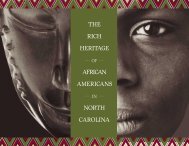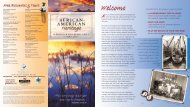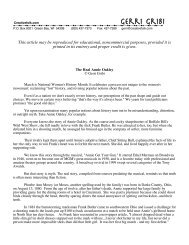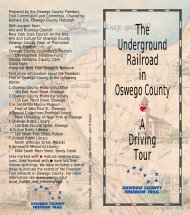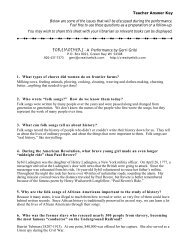African American Heritage Trail - Lexington, Kentucky Convention ...
African American Heritage Trail - Lexington, Kentucky Convention ...
African American Heritage Trail - Lexington, Kentucky Convention ...
You also want an ePaper? Increase the reach of your titles
YUMPU automatically turns print PDFs into web optimized ePapers that Google loves.
<strong>African</strong> <strong>American</strong> <strong>Heritage</strong> <strong>Trail</strong> in Downtown <strong>Lexington</strong><br />
by Doris Wilkinson<br />
printed from the website of the <strong>Lexington</strong> <strong>Convention</strong> and Visitors Bureau<br />
The "<strong>African</strong> <strong>American</strong> <strong>Heritage</strong> <strong>Trail</strong> in Downtown <strong>Lexington</strong>, <strong>Kentucky</strong>" symbolizes a historic passageway from the<br />
site of a 19th century slave auction block at "cheapside" to freedom represented by the Urban League headquarters at<br />
148 Deweese Street. Along the route, <strong>African</strong> <strong>American</strong>s contributed immensely to the rich cultural heritage of the<br />
city. Many of their architectural landmarks and historic properties, including cemeteries, may be found throughout the<br />
city and in the once rural hamlets of Fayette county.<br />
Source: Doris Wilkinson "A Guide to the <strong>African</strong> <strong>American</strong> <strong>Heritage</strong> in Downtown <strong>Lexington</strong>, <strong>Kentucky</strong>."<br />
Copyright 2000<br />
1. Main Street Baptist Church, 582 West Main Street<br />
2. "Forgotten Pioneers," A doctor's office that was located at 118 North Broadway<br />
3. Cheapside<br />
4. Historic Pleasant Green, 540 West Maxwell Street<br />
5. Baptism scene, between Bolivar and Scott Streets<br />
6. Home of Isaac Murphy, Eastern Street<br />
7. St. Paul AME Church, 251-253 North Upper Street<br />
8. Old First Baptist site, corner of Short and DeWeese<br />
9. Polk-Dalton Infirmary, 148 DeWeese<br />
10. East Second Street Christian Church, 146 Constitution Street<br />
Doris Wilkinson<br />
Project on the <strong>African</strong> <strong>American</strong> <strong>Heritage</strong><br />
c/o Department of Sociology<br />
University of <strong>Kentucky</strong><br />
<strong>Lexington</strong>, <strong>Kentucky</strong> 40506-0027
1. Main Street Baptist Church.<br />
582 West Main Street<br />
Originally the Independent Baptist church, the foundation for Main Street Baptists<br />
was anchored in 1862--one year before the signing of the Emancipation<br />
Proclamation. Since 1870, the quaint and historic church has been at its present<br />
location. Situated next door to the Mary Todd Lincoln House, this notable place<br />
of worship has served as a prominent institution in the <strong>Lexington</strong> community. It<br />
is a major landmark in the downtown section of the city.<br />
Photo courtesy of the <strong>Lexington</strong> <strong>Convention</strong> and Visitors Bureau<br />
2. Forgotten Pioneers: <strong>African</strong> <strong>American</strong> doctors in <strong>Lexington</strong><br />
118 North Broadway<br />
In the early part of the twentieth century, several <strong>African</strong> <strong>American</strong> doctors<br />
practiced in <strong>Lexington</strong>. Many were in the building at 118 North Broadway near<br />
West Main Street. The distinguished structure once housed the offices of such<br />
well-known physicians as Obed Cooley, John E. Hunter, Nathaniel Ridley, and<br />
Joseph Laine from Clark County (Winchester). W.T. Dinwiddie--a dentist--also<br />
had his office in the building. Some of these doctors were at the location from<br />
1909-1930--a period in the country's economic and political history that included<br />
World War I and the Great Depression.<br />
Photo courtesy of Doris Wilkinson<br />
3. Cheapside<br />
During the dark era of slavery in <strong>Kentucky</strong>, the section of town in <strong>Lexington</strong><br />
known as "cheapside" became the largest slave-trading locality in the state. In<br />
fact, the area was one of the most well known of the slave market districts in the<br />
South. <strong>African</strong>s were beaten and families were separated forever as they were<br />
auctioned and sold in the courtyard. According to historical narratives, President<br />
Abraham Lincoln once observed the selling of slaves at this site. In the post-war<br />
period, "cheapside" served as a public square and a market. This photograph<br />
shows a court day in November 1887.<br />
Photo used by permission: Audio-Visual Archives, Special Collections,<br />
University of <strong>Kentucky</strong> Libraries<br />
4.Historic Pleasant Green Baptist Church<br />
540 West Maxwell<br />
Referred to as the "oldest Baptist church west of the Allegheny Mountains," the<br />
roots of Pleasant Green were planted in 1790--the year that the first census of the<br />
United States was taken. The slave, "Old Captain," Peter Duerett, is credited with<br />
having founded the first <strong>African</strong> Baptist Church in <strong>Lexington</strong>. In 1822, the land<br />
was conveyed to slaves. The present church at West Maxwell changed its name to<br />
"Pleasant Green" in 1829. The landmark building was completed following the<br />
stock market crash that launched the beginning of the Great Depression<br />
Photo courtesy of <strong>Lexington</strong> <strong>Convention</strong> and Visitors Bureau<br />
5. Baptism Scene<br />
Around the beginning of the 20th century, Historic Pleasant Green Baptist Church<br />
carried out its baptisms in a pond that was once situated between Bolivar and Scott<br />
Streets. For many years, rousing baptismal services were held at the pond off<br />
South Upper. According to oral tradition, this electrifying spiritual event drew<br />
large crowds of families and represented an important component of declaring<br />
one's faith.<br />
Photo used by permission: J. Winston Coleman Photographic<br />
Collection, Transylvania University Library.<br />
page 2
6. Isaac Murphy (1861-1896)<br />
Born on a horse farm in <strong>Lexington</strong>, Isaac (Burns) Murphy is well known in the<br />
history of Thoroughbred racing. A leading jockey of his time, Murphy's family<br />
once lived in downtown <strong>Lexington</strong> on "Jordan's Row," which "faced the public<br />
square." (In 1805, Henry Clay's law office was also located on "Jordan's Row," the<br />
present day 110-112 North Upper.) Later, Murphy lived on Megowan Street near<br />
the Thoroughbred Park. In 1884, 1890 and 1891, he won the <strong>Kentucky</strong> Derby.<br />
Murphy is buried in the <strong>Kentucky</strong> Horse Park cemetery on Iron Works Pike where<br />
his remains were moved in 1977.<br />
Photo courtesy of <strong>Kentucky</strong> State University Special Collections & Archives<br />
7. St. Paul AME Church<br />
251-253 North Upper Street<br />
This most important landmark was an outgrowth of the Hill Street Methodist<br />
Church--a place where white slaveholders and overseers gave instructions to<br />
<strong>African</strong> slaves. Around 1826, a small brick building was constructed on North<br />
upper. Throughout the 20th century, the <strong>African</strong> Methodist Episcopal Church<br />
sustained its role as an active and positive force in the community. <strong>African</strong><br />
<strong>American</strong> war mothers met here during World War II (1939-1945). Mrs. Lucy<br />
Harth Smith, a well-known educator in the city, was a participant in those historic<br />
meetings.<br />
Photo courtesy of <strong>Lexington</strong> <strong>Convention</strong> and Visitors Bureau<br />
8. Site of the Old First Baptist Church<br />
corner of Short and Deweese<br />
For decades, First Baptist--a legendary church--stood at the corner of Short and<br />
Deweese, "the heart of the <strong>African</strong> <strong>American</strong>" community. It is "one of the oldest<br />
<strong>African</strong> <strong>American</strong> congregations in the state of <strong>Kentucky</strong>" and also has roots in the<br />
<strong>African</strong> Baptist church. Established during slavery, the original First Baptist served<br />
as a major religious and cultural institution throughout the 19th and 20th centuries.<br />
This celebrated house of worship has been referred to as "one of the connecting<br />
links in the underground railroad." In the latter part of the 20th century, the historic<br />
church relocated to Price Road as First <strong>African</strong> Baptist.<br />
Photo courtesy of <strong>Lexington</strong> <strong>Convention</strong> and Visitors Bureau (Deweese and Short,<br />
formerly the site of First Baptist)<br />
9. Historic <strong>African</strong> <strong>American</strong> Health Center: Polk-Dalton Infirmary<br />
148 Deweese<br />
At 148 Deweese, in the center of the <strong>Lexington</strong> <strong>African</strong> <strong>American</strong> cultural and<br />
residential community, Dr. John Polk set up his medical practice from 1921 to<br />
1931. He was the first physician to have occupied the historic structure. Dr. J.R.<br />
Dalton later established his medical practice in this building where he stayed for<br />
many decades. Other <strong>African</strong> <strong>American</strong> doctors who joined him on Deweese<br />
(Dewees) Street included Dr. Henry Merchant who arrived during the Great<br />
Depression and Dr. Marshall Jones who set up his practice in the post-World War II<br />
period. This landmark is presently the headquarters for the <strong>Lexington</strong>-Fayette<br />
County Urban League which had its grand opening in 1999.<br />
Photo courtesy of <strong>Lexington</strong> <strong>Convention</strong> and Visitors Bureau<br />
10. East Second Street Christian Church<br />
146 Constitution<br />
The East Second Street Christian Church began its religious services in an old<br />
carriage factory. This small but celebrated house of worship among "Disciples of<br />
Christ" originated in 1852 under the leadership of Thomas Phillips. The doors<br />
opened at the time of the greatest activity on the "underground railroad." In 1880,<br />
the present site was purchased--just two decades after the Emancipation<br />
Proclamation was signed. This remarkable church represents an intrinsic part of an<br />
historical neighborhood that is in close proximity to downtown <strong>Lexington</strong>.<br />
Photo courtesy of <strong>Lexington</strong> <strong>Convention</strong> and Visitors Bureau<br />
page 3
<strong>African</strong> <strong>American</strong> <strong>Heritage</strong> <strong>Trail</strong> in Downtown <strong>Lexington</strong><br />
Selected References on <strong>Lexington</strong>’s <strong>African</strong> <strong>American</strong> <strong>Heritage</strong><br />
Borries, B.E. Isaac Murphy: <strong>Kentucky</strong>'s Record Jockey. Berea, <strong>Kentucky</strong>: Kentucke Imprints, 1988.<br />
Hopkins, S. "Down memory lane: A place in history." <strong>Lexington</strong> Herald-Leader (March 22,2000).<br />
Lacer, B. "Professor revisits her past." <strong>Kentucky</strong> Kernel (November 25, 1996).<br />
<strong>Lexington</strong>-Fayette County Historic Commission, "Henry Clay's Building"/ William w. Worsley Printing House. <strong>Kentucky</strong><br />
Historic Resources Inventory, June 1979. Site No. Fa-LDT-193.<br />
McIntyre, L. One grain of the salt: The First <strong>African</strong> Baptist Church West of the Allegheny Mountians. L.H. McIntyre,<br />
1986.<br />
Peoples, T. (ed.). Essence of a Saga; A Complete History of the Oldest Black Baptist Congregation West of the Allegheny<br />
Mountains. Historic Pleasant Green Missionary Baptist Church. <strong>Lexington</strong>, <strong>Kentucky</strong>, 1990.<br />
Stewart, F. "Professor works to ensure early black doctors not forgotten." Communi-K 21 (August 29, 1988).<br />
Wilkinson, D. Directory of Afro-<strong>American</strong> Physicians in <strong>Lexington</strong> and Fayette County from Post-Reconstruction to the<br />
Pre-Civil rights Era: 1890-1950. <strong>Lexington</strong>, <strong>Kentucky</strong>: University of <strong>Kentucky</strong>, Department of Sociology, 1989.<br />
Williams, J. "The revolution of 1954." <strong>Kentucky</strong> Kernel (October 14, 1999).<br />
Wright, J. <strong>Lexington</strong>: A Century in Photographs. <strong>Lexington</strong>, <strong>Kentucky</strong>. <strong>Lexington</strong>-Fayette County Historic Commission,<br />
1984.<br />
Back to <strong>African</strong> <strong>American</strong> <strong>Heritage</strong> <strong>Trail</strong> in Downtown <strong>Lexington</strong> map.<br />
Source: Doris Wilkinson "A Guide to the <strong>African</strong> <strong>American</strong> <strong>Heritage</strong> in Downtown <strong>Lexington</strong>, <strong>Kentucky</strong>." Copyright 2000<br />
Doris Wilkinson<br />
Project on the <strong>African</strong> <strong>American</strong> <strong>Heritage</strong><br />
c/o Department of Sociology<br />
University of <strong>Kentucky</strong><br />
<strong>Lexington</strong>, <strong>Kentucky</strong> 40506-0027<br />
printed from the website of the <strong>Lexington</strong> <strong>Convention</strong> and Visitors Bureau<br />
page 4



